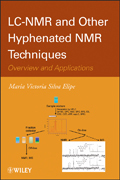
LC-NMR and other hyphenated NMR techniques: overview and applications
Silva Elipe, Maria V.
This practical guide provides a basic overview of the pros and cons of NMR spectroscopy as both a hyphenated and non-hyphenated technique. The book begins with a description of basic NMR concepts for the structural elucidation of organic compounds and then details the historical development of NMR and hyphenated NMR in the structural elucidation world, followed by applications of hyphenated NMR as LC-NMR and LC-MS-NMR in industry and academia. It also contains updated information on the latest advancements and applications of LC-NMR in such areas as degradation products, drug metabolism, food analysis, and drug discovery. An essential resource for scientists in industry and academia who work in the areas of organic chemistry, medicinal chemistry, process chemistry, andanalytical chemistry. INDICE: 1. Basic Concepts on NMR Spectroscopy. 1.1Introduction. 1.2 Basic knowledge on the physics of NMR spectroscopy. 1.3 Basic parameters for NMR interpretation. 1.4 Conclusions. 1.5 References. 2. Historical development of NMRand LC-NMR. 2.1 Introduction. 2.2 Historical development of NMR. 2.3 Historical development of LC-NMR. 2.4 Historical development of other analytical techniques hyphenated with NMR. 2.5 Current trends. 2.6 References. 3. Basic technical considerations and operations for LC-NMR and MC-MS-NMR. 3.1 Introduction. 3.2 Technical considerations for LC-NMR. 3.3 Technical considerations for LC-MS-NMR. 3.4 Mode of operations for LC-NMR. 3.5 Mode of operation for LC-MS-NMR.3.6 Other modes of operation. 3.7 Challenging considerations. 3.8 Conclusions. 3.9 References. 4. Applications of LC-NMR. 4.1 Introduction. 4.2 Applications for LC-NMR. 4.3 Conclusions and future trends. 4.4 References. 5. Applications of LC-MS-NMR. 5.1 Introduction. 5.2 Applications for LC-MS-NMR. 5.3 Conclusions and future trends. 5.4 References. 6. Hyphenation of NMR with other analytical separation techniques. 6.1 Introduction. 6.2 GC-NMR. 6.3 GPC-NMR. 6.4 SEC-NMR. 6.5 SFC-NMR. 6.6 SFE-NMR. 6.7 CE-NMR. 6.8 CEC-NMR. 6.9 CZE-NMR. 6.10 cITP-NMR. 6.11 CapLC-NMR. 6.12 SPE-NMR. 6.13 SPE-MS-NMR. 6.14 Conclusions and future trends. 6.15 References. 7. Special topics and applications related to LC-NMR. 7.1 Introduction. 7.2 Off-line versus on-line NMR for structure elucidation. 7.3 Analysis of chiral molecules by LC-NMR. 7.4 Monitoring chemical reaction in situ. 7.5 Analysis of mixtures off-line, on-line, and by other NMR methodologies. 7.6 Current Trends. 7.7 References.
- ISBN: 978-0-470-54834-9
- Editorial: John Wiley & Sons
- Encuadernacion: Cartoné
- Páginas: 238
- Fecha Publicación: 06/01/2012
- Nº Volúmenes: 1
- Idioma: Inglés
